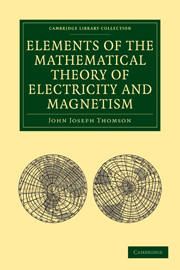Book contents
- Frontmatter
- PREFACE TO FIRST EDITION
- PREFACE TO THE SECOND EDITION
- PREFACE TO THE THIRD EDITION
- PREFACE TO THE FOURTH EDITION
- Contents
- CHAP. I General Principles of Electrostatics
- CHAP. II Lines of Force
- CHAP. III Capacity of Conductors. Condensers
- CHAP. IV Specific Inductive Capacity
- CHAP. V Electrical Images and Inversion
- CHAP. VI Magnetism
- CHAP. VII Terrestrial Magnetism
- CHAP. VIII Magnetic Induction
- CHAP. IX Electric Currents
- CHAP. X Magnetic Force due to Currents
- CHAP. XI Electromagnetic Induction
- CHAP. XII Electrical Units: Dimensions of Electrical Quantities
- CHAP. XIII Dielectric Currents and the Electromagnetic Theory of Light
- CHAP. XIV Thermoelectric Currents
- CHAP. XV The Properties of Moving Electric Charges
- INDEX
CHAP. VI - Magnetism
Published online by Cambridge University Press: 07 September 2010
- Frontmatter
- PREFACE TO FIRST EDITION
- PREFACE TO THE SECOND EDITION
- PREFACE TO THE THIRD EDITION
- PREFACE TO THE FOURTH EDITION
- Contents
- CHAP. I General Principles of Electrostatics
- CHAP. II Lines of Force
- CHAP. III Capacity of Conductors. Condensers
- CHAP. IV Specific Inductive Capacity
- CHAP. V Electrical Images and Inversion
- CHAP. VI Magnetism
- CHAP. VII Terrestrial Magnetism
- CHAP. VIII Magnetic Induction
- CHAP. IX Electric Currents
- CHAP. X Magnetic Force due to Currents
- CHAP. XI Electromagnetic Induction
- CHAP. XII Electrical Units: Dimensions of Electrical Quantities
- CHAP. XIII Dielectric Currents and the Electromagnetic Theory of Light
- CHAP. XIV Thermoelectric Currents
- CHAP. XV The Properties of Moving Electric Charges
- INDEX
Summary
111. A mineral called ‘lodestone’ or magnetic oxide of iron, which is a compound of iron and oxygen, is often found in a state in which it possesses the power of attracting small pieces of iron such as iron filings; if the lodestone is dipped into a mass of iron filings and then withdrawn, some of the iron filings will cling to the lodestone, collecting in tufts over its surface. The behaviour of the lodestone is thus in some respects analogous to that of the rubbed sealing-wax in the experiment described in Art. 1. There are however many well-marked differences between the two cases; thus the rubbed sealing-wax attracts all light bodies indifferently, while the lodestone does not show any appreciable attraction for anything except iron and, to a much smaller extent, nickel and cobalt.
If a long steel needle is stroked with a piece of lodestone, it will acquire the power possessed by the lodestone of attracting iron filings; in this case the iron filings will congregate chiefly at two places, one at each end of the needle, which are called the poles of the needle.
The piece of lodestone and the needle are said to be magnetized; the attraction of the iron filings is an example of a large class of phenomena known as magnetic. Bodies which exhibit the properties of the lodestone or the needle are called magnets, and the region around them is called the magnetic field.
- Type
- Chapter
- Information
- Elements of the Mathematical Theory of Electricity and Magnetism , pp. 191 - 231Publisher: Cambridge University PressPrint publication year: 2009First published in: 1895

